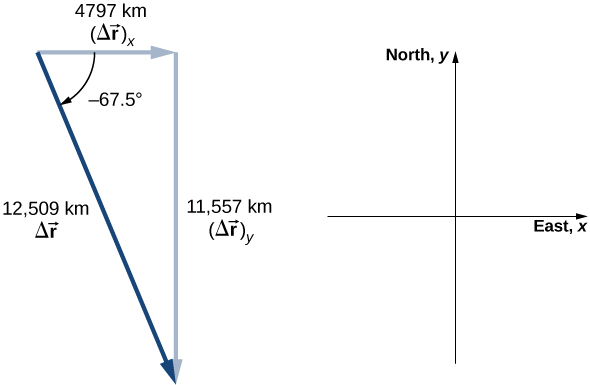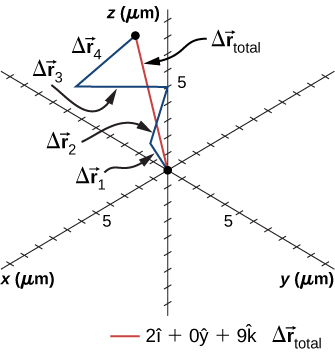| << Chapter < Page | Chapter >> Page > |
In unit vector notation, the position vectors are
Evaluating the sine and cosine, we have
Now we can find , the displacement of the satellite:
The magnitude of the displacement is The angle the displacement makes with the x- axis is

Note that the satellite took a curved path along its circular orbit to get from its initial position to its final position in this example. It also could have traveled 4787 km east, then 11,557 km south to arrive at the same location. Both of these paths are longer than the length of the displacement vector. In fact, the displacement vector gives the shortest path between two points in one, two, or three dimensions.
Many applications in physics can have a series of displacements, as discussed in the previous chapter. The total displacement is the sum of the individual displacements, only this time, we need to be careful, because we are adding vectors. We illustrate this concept with an example of Brownian motion.
What is the total displacement of the particle from the origin?

To complete the solution, we express the displacement as a magnitude and direction,
with respect to the x -axis in the xz- plane.
In the previous chapter we found the instantaneous velocity by calculating the derivative of the position function with respect to time. We can do the same operation in two and three dimensions, but we use vectors. The instantaneous velocity vector is now
Let’s look at the relative orientation of the position vector and velocity vector graphically. In [link] we show the vectors and which give the position of a particle moving along a path represented by the gray line. As goes to zero, the velocity vector, given by [link] , becomes tangent to the path of the particle at time t .

Notification Switch
Would you like to follow the 'University physics volume 1' conversation and receive update notifications?